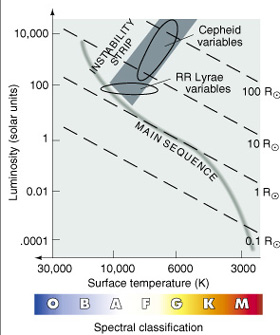http://en.wikipedia.org/wiki/RR_Lyrae_variable wrote:
<<RR Lyrae variables are periodic variable stars, commonly found in globular clusters, and often used as standard candles to measure galactic distances. RR Lyraes are pulsating horizontal branch stars of spectral class A (and rarely F), with a mass of around half the Sun's. They are thought to have previously shed mass and consequently, they were once stars with similar or slightly less mass than the Sun, around 0.8 solar masses.
RR Lyrae stars pulse in a manner similar to Cepheid variables, so the mechanism for the pulsation is thought to be similar, but the nature and histories of these stars is thought to be rather different. In contrast to Cepheids, RR Lyraes are old, relatively low mass, metal-poor "Population II" stars. They are much more common than Cepheids, but also much less luminous. (The average absolute magnitude of an RR Lyrae is 0.75, only 40 or 50 times brighter than our Sun.) Their period is shorter, typically less than one day, sometimes ranging down to seven hours.
The relationship between pulsation period and absolute magnitude of RR Lyraes makes them good standard candles for relatively near objects, especially within the Milky Way. They are extensively used in globular cluster studies, and also used to study chemical properties of older stars.>>

RR Lyrae stars were formerly called "cluster variables" because of their strong (but not exclusive) association with globular clusters; conversely, about 90% of all variables known in globular clusters are RR Lyraes. RR Lyrae stars are found at all galactic latitudes, as opposed to classical Cepheid variables, which are strongly associated with the galactic plane.
Several times as many RR Lyraes are known as all Cepheids combined; in the 1980s, about 1900 were known in globular clusters. Some estimates have about 85000 in the Milky Way.
From 1915 to the 1930s, the RR Lyraes became more accepted as a distinct class of star from classical Cepheids, on account of their shorter periods, different location within the galaxy, and finally, they are chemically different from classical Cepheids, being mostly metal-poor, Population II stars.
RR Lyraes have proven difficult to observe in external galaxies, because of their intrinsic faintness. (In fact, Walter Baade's failure to find them in the Andromeda galaxy led him to suspect that the galaxy was much farther away than predicted, and to re-consider the calibration of Cepheid variables and to propose stellar populations.) They were finally found in the 1980s by Pritchet & van den Bergh in the halo of the Andromeda galaxy, and more recently in its globular clusters by the Hubble Space Telescope.
 VAR
VAR



